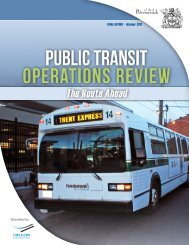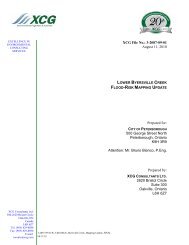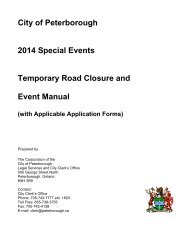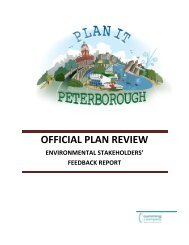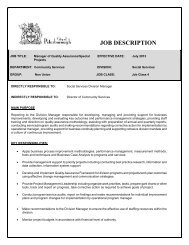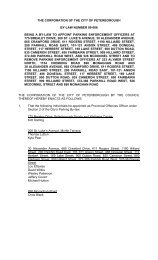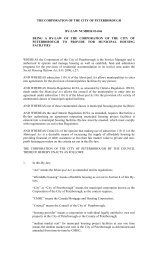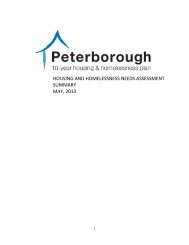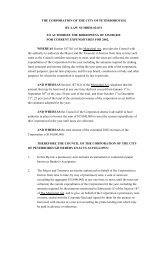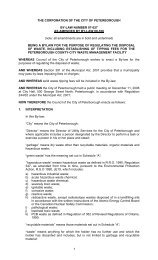Thompson Creek Flood Study Report - City of Peterborough
Thompson Creek Flood Study Report - City of Peterborough
Thompson Creek Flood Study Report - City of Peterborough
You also want an ePaper? Increase the reach of your titles
YUMPU automatically turns print PDFs into web optimized ePapers that Google loves.
<strong>Thompson</strong> <strong>Creek</strong> Detailed <strong>Flood</strong> Reduction <strong>Study</strong><br />
<strong>City</strong> <strong>of</strong> <strong>Peterborough</strong><br />
J-1 Minor system data and connectivity – <strong>Thompson</strong> <strong>Creek</strong> systems<br />
J-2 Listing <strong>of</strong> major/minor system outlets – <strong>Thompson</strong> <strong>Creek</strong> systems<br />
J-3 Major system data and connectivity – <strong>Thompson</strong> <strong>Creek</strong> systems<br />
J-4 Major system rating curves – <strong>Thompson</strong> <strong>Creek</strong> systems<br />
J-5 Catchbasin capture curves – <strong>Thompson</strong> <strong>Creek</strong> systems<br />
J-6 Subcatchment data – <strong>Thompson</strong> <strong>Creek</strong> systems<br />
J-7 Minor system data & connectivity – Otonabee River local drainage systems<br />
J-8 Listing <strong>of</strong> major/minor system outlets – Otonabee River local drainage systems<br />
J-9 Major system data and connectivity – Otonabee River local drainage systems<br />
J-10 Major system rating curves – Otonabee River local drainage systems<br />
J-11 Catchbasin capture curves – Otonabee River local drainage systems<br />
J-12 Subcatchment data – Otonabee River local drainage systems<br />
This data was obtained from the <strong>City</strong>’s Geographic Information System and Sewer<br />
Database and was verified and supplemented as necessary through detailed field<br />
surveys. In general, the field survey provided information on missing sewer inverts or<br />
pipe sizes. Detailed information is provided in Appendix J-13.<br />
4.4.3.2 Model Verification<br />
Model verification consisted <strong>of</strong> simulating the flows from three measured rainfall<br />
events from the monitoring period and comparing the results with measured flows at the<br />
outlet from the storm sewer system at the intersection <strong>of</strong> Scollard Drive and Francis<br />
Stewart Road. Of the eight local systems within the study area, this was the one system<br />
chosen for monitoring. The events selected were the three largest recorded flows in the<br />
April to June 2006 period. They included the same event as used for the OTTHYMO<br />
model i.e. a storm which occurred at about 2:00 am on June 1, 2006. As previously<br />
discussed, it was approximately a 1 in 2 year rainfall for its three hour duration. Hence<br />
this was a significant event upon which to base the model verification. At the sewer<br />
system outlet, the 3 events had flows <strong>of</strong> 0.32 m 3 /s, 0.18 m 3 /s and 0.76 m 3 /s respectively.<br />
The recorded rainfalls for the three events at the <strong>City</strong> Hall gauge were input to the<br />
OTTSWMM model <strong>of</strong> the Scollard Drive/Francis Stewart Road system and the<br />
resulting flows estimated. <strong>City</strong> Hall data was used since it is recorded in 5 minute<br />
intervals whereas the Trent University data is only recorded in 30 minute increments.<br />
Table 4.4.4 compares the observed and simulated peak flows for the three events.<br />
Figure 4.4.3 shows the observed and simulated hydrographs for the June 1, 2006 event.<br />
14-06605-01-W01 <strong>City</strong> <strong>of</strong> <strong>Peterborough</strong> 51




